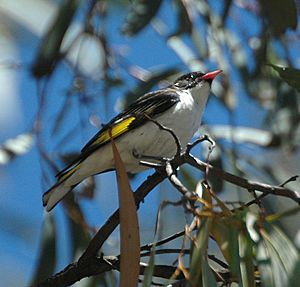Clarkesdale Bird Sanctuary facts for kids
The Clarkesdale Bird Sanctuary is a special nature reserve in Victoria, Australia. It's near a small town called Linton, about 30 km southwest of the city of Ballarat. This sanctuary works hard to protect and bring back natural homes for woodland birds.
How It Started
The idea for the Clarkesdale Bird Sanctuary began in the 1960s. A sheep farmer named Gordon Clarke, who loved watching birds, wanted to help nature. He started by removing a plant called gorse, which was an invasive weed in the area.
Gordon then planted one of his fields with many different Australian native plants. He wanted to give birds food and shelter. This first piece of land was about 31 hectares (about 76 acres) and was called the "Bird Paddock." Gordon bought it in 1957, and it had never been heavily grazed by animals.
In 1975, Gordon gave this land to Bird Observation & Conservation Australia (BOCA), which was then known as the Bird Observers Club. This was when the land officially became a reserve.
In 1980, Gordon donated another 13 hectares (about 32 acres) of land to the club. He named this section "Grantiella" after the scientific name for the painted honeyeater bird. During the 1980s, Gordon bought more small pieces of land next to the reserve. He gave these to the Trust for Nature to make the sanctuary even bigger.
Gordon Clarke passed away in 1996 when he was 89 years old. He had set up a special fund, the Gordon Clarke Trust Fund, to make sure the sanctuary would be protected and cared for in the future.
What It's Like Now
Today, the Clarkesdale Bird Sanctuary covers about 535 hectares (about 1,322 acres). This includes some nearby government land that is also a flora and fauna reserve. Much of the land used to be farms, including an apple orchard and a pine tree farm, as well as fields for sheep.
Now, the sanctuary is working to bring back the natural woodland plants. There are also some small man-made wetlands on the reserve. A special committee from BOCA and a resident park ranger manage the sanctuary. Many volunteers, called the Friends of Clarkesdale, help with planting and maintenance work.
Plants and Trees
The natural forest in the area is called "heathy dry forest." For many years, people cut down trees and disturbed the land. The main trees you'll see are messmate, candlebark, red stringybark, and swamp gum. These trees form an open canopy about 20 meters (65 feet) tall.
Below these tall trees, there's a lower, thinner layer of shrubs. You might find plants like myrtle wattle, black wattle, golden bush-pea, drooping cassinia, and common heath. There are also small grass-trees and austral bracken ferns.
Goals and Successes
Gordon Clarke's first goal was to create a place with more food for birds than a natural forest. So, he mostly planted shrubs and trees that produce nectar, especially from Western Australia. He didn't plant local trees like stringybarks because they didn't fit his vision.
Because of his early plantings, some honeyeater birds, like New Holland honeyeaters and red wattlebirds, are much more common here than in natural forests. However, other birds, like treecreepers, are more common in the natural forests next to the sanctuary.
The current goal for the sanctuary, set in 1999, is to "make and manage the habitat at Linton as a Sanctuary to increase the variety and numbers of native birds forever." The main aim is to help stop the decline of woodland birds, which are considered a threatened group of animals under Victoria's Flora and Fauna Guarantee Act 1988.
In 2003, Clarkesdale was a finalist in the Banksia Awards, which recognize great environmental work. It was nominated in the category for "Protecting Bush, Land and Waterways."


